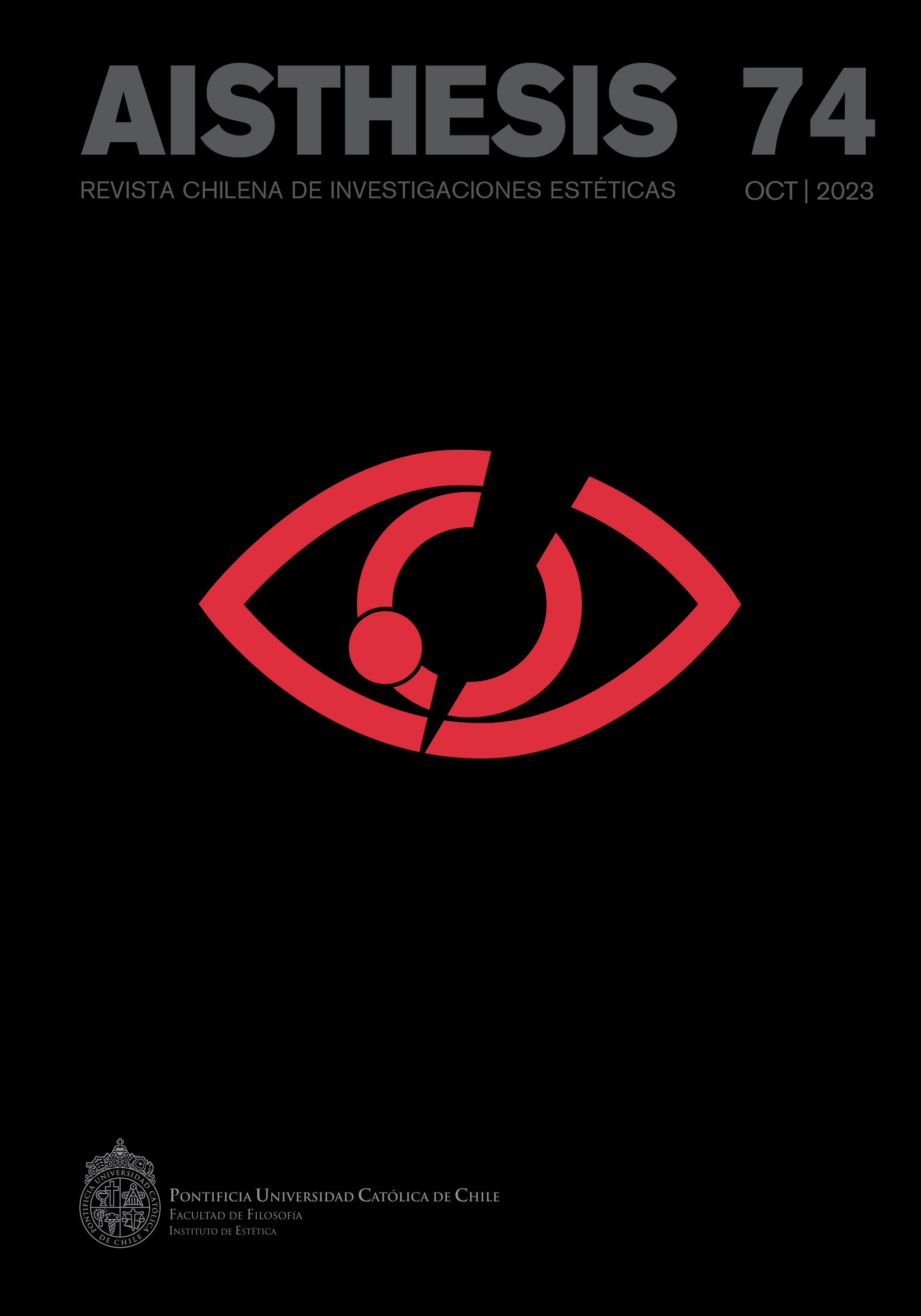Optical Unconscious: Declassification, Image and Conspiracy. Anaconda Copper Mining Company (1970) and Map of Chile (Anaconda) (1975)
Main Article Content
Abstract
This article will develop the problem of the image as a key to reading on the conspiracy against the nationalization of Chilean copper at the beginning of the seventies. By exploring the concept of damaged or degraded images that have been displaced from the line of historical continuity of the Popular Unity, two visual records will be analyzed: the declassification of documents related to the interests of the North American company Anaconda Copper Mining Company in 1970, and the records of the work Map of Chile (Anaconda) by the Chilean artist, Juan Downey, at the Center for Inter-American Relations (CIAR) in New York in 1975. Thus, through this encounter between image, art and politics, a discussion on the optical and political unconscious will take place, as part of a critical thought on the images of the Popular Unity.
Downloads
Article Details

This work is licensed under a Creative Commons Attribution-NonCommercial-ShareAlike 4.0 International License.
All contents of this electronic edition are distributed under the Creative Commons license of "Attribución-shareAlike 4.0 Internacional" (CC-BY-SA). Any total or partial reproduction of the material must mention its origin.
The rights of academic works published in this publication belong to their authors., who grant to AISTHESIS: Revista Chilena de Investigaciones Estéticas the license for its use. The management of the permits and the authorization of the publication of the images (or of any material) that contains copyright and its consequent rights of reproduction in this publication is the sole responsibility of the authors of the articles
References
Referencias
Alvear Urrutia, Jorge. Chile. Nuestro cobre: Chuquicamata, El Salvador, Potrerillos, El Teniente, Enami, Mantos Blancos y Andina. Editorial Lastra, 1975.
Benjamin, Walter. «La obra de arte en la época de la reproductibilidad técnica». Discursos Interrumpidos, 1989 [1934], pp. 15-57.
––. «Sobre el concepto de historia». Discursos Interrumpidos I. Taurus, 1989 [1931], pp. 173-191.
Bozer, Julian. «Juan Downey’s “Anaconda” Map of Chile, 1975». Shift, nº 11, 2018, pp. 17-30.
Brea, José Luis. «Cambio de régimen escópico: del inconsciente óptico a la e-image». Arte, archivo y tecnología. Eds. Alejandra Castillo y Cristián Gómez-Moya. Ediciones Finis Terrae, 2012.
Buntinx, Gustavo. «Contra las sombras de Juan Downey, hacia la oscuridad y la luz». Juan Downey, The Invisible Architect. Ed. Valerie Smith. MIT List Visual Arts Center/Bronx Museum of the Arts, 2011, pp. 221-233.
Contraloría General de la República. «Ley 17.426, de 27 de abril de 1971, a la ley 17.630, de 10 de marzo de 1972». Edición oficial, La Contraloría, 1971.
Falconi, José Luis y Gabriela Rangel. A Principality of Its Own: 40 Years of Visual Arts at the Americas Society. Americas Society, 2006.
Gómez-Moya, Cristián y Miguel Valderrama. Inventario. Hegemonía y Visualidad, Palinodia, 2019.
González, Julieta y Arely Ramírez, editoras. Una utopía de la comunicación/A Communications Utopia. Fundación Olga y Rufino Tamayo, 2013.
Kissinger, Henry. Mis memorias, volumen I. Editorial Atlántida, 1979.
––. Mis memorias, volumen II. Editorial Atlántida, 1982.
Kornbluh, Peter. «Documentos desclasificados: Cómo Jorge Alessandri buscó apoyo clandestino de EE. UU. en 1970». CIPER, 12 dic. 2007. https://www.ciperchile.cl/2007/12/12/documentos-desclasificados-como-jorge-alessandri-busco-apoyo-clandestino-de-eeuu/
––. Pinochet desclasificado. Los archivos secretos de Estados Unidos en Chile. Catalonia, 2023.
––. Krauss, Rosalind. El inconsciente óptico. Editorial Tecnos, 1997 [versión original: The Optical Unconscious 1993].
Jameson, Fredric. The Political Unconscious: Narrative as a Socially Symbolic Act. Cornell University Press, 1981 [Traducción: Documentos de cultura, documentos de barbarie, 1989].
––. «Cognitive Mapping». Marxism and the Interpretation of Culture. Eds. Cary Nelson y Lawrence Grossberg. University of Illinois Press, 1988, pp. 347-360.
––. Postmodernism, or The Cultural Logic of Late Capitalism. Verso, 1991.
––. The Geopolitical Aesthetic: Cinema and Space in the World System. Indiana University Press, 1992 [Traducción: La estética geopolítica, 2018].
––. Giro cultural. Escritos seleccionados sobre el postmodernismo. 1983-1998. Manantial, 2002.
Oramas, Luis Pérez. «Looking South: Strategic Visions, Tactical Revisions». A Principality of Its Own: 40 Years of Visual Arts at the Americas Society. Eds. José Luis Falconi y Gabriela Rangel. Americas Society, 2006.
Poveda Bonilla, Rafael. «Estudio de caso sobre la gobernanza del cobre en Chile». Documentos de Proyectos (LC/TS.2019/48). Comisión Económica para América Latina y el Caribe (CEPAL), Santiago de Chile, 2019.
Programa Básico de Gobierno de la Unidad Popular, Santiago de Chile, 1970 (sin lugar de edición).
Rancière, Jacques. El inconsciente estético. Del Estante Editorial, 2005.
Richard, Nelly. «Lo político en el arte: arte, política e instituciones». emisférica, 6.2 Cultura + Derechos + Instituciones, Instituto Hemisférico de Performance y Política, NYU, 2009. https://hemi.nyu.edu/hemi/en/e-misferica-62/richard
Rockefeller Panel Reports. Prospect for America. Doubleday & Co., 1961.
––. The Performing Arts: Problems and Prospects. McGraw-Hill Book Company, 1965.
Ruiz, Raúl. «Inconscientes fotográficos». Poéticas del cine. Ediciones UDP, 2014, pp. 70-83.
Steyerl, Hito. Los condenados de la pantalla. Caja Negra, 2014.
Toscano, Alberto y Jeff Kinkle. Cartografías de lo absoluto. Materia Oscura Ediciones, 2018.
Vergara, Ángela. «Precios fijos y raciones: la Anaconda Copper Company en Chile entre 1932 y 1958». Investigaciones de Historia Económica, vol. 8, nº 3, 2019, pp. 135-143. https://doi.org/10.1016/j.ihe.2012.04.002
Weigel, Sigrid. «El detalle en las imágenes fotográficas y cinematográficas. Sobre la significación de la historia de los medios para la teoría de la cultura de Walter Benjamin». Boletín de Estética, nº 19, 2012, pp. 5-44.
––. «El relámpago del conocer: pintura y fotografía como palimpsesto del pensamiento benjaminiano de las imágenes». Revista Papel Máquina, nº 17, 2023, pp. 79-118.
Wildi, Ingrid, editora/curadora. Arquitectura de las transferencias. Arte, política y tecnología. Abada Editores, 2016.
Zauschquevich, Andrés y Alexander Sutulov, coordinadores. El cobre chileno/Corporación del Cobre. Editorial Universitaria, 1975.
